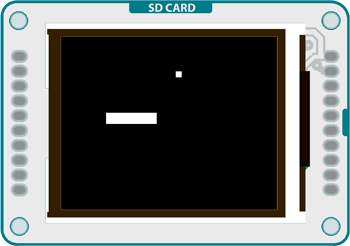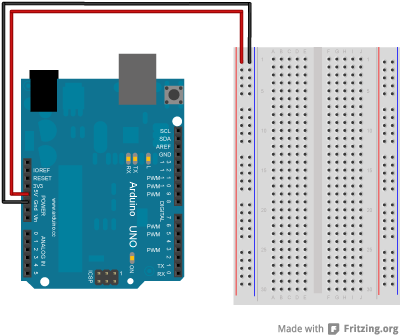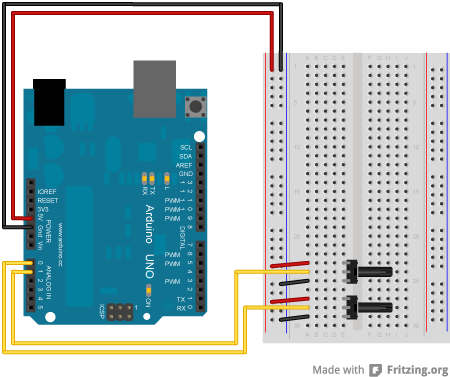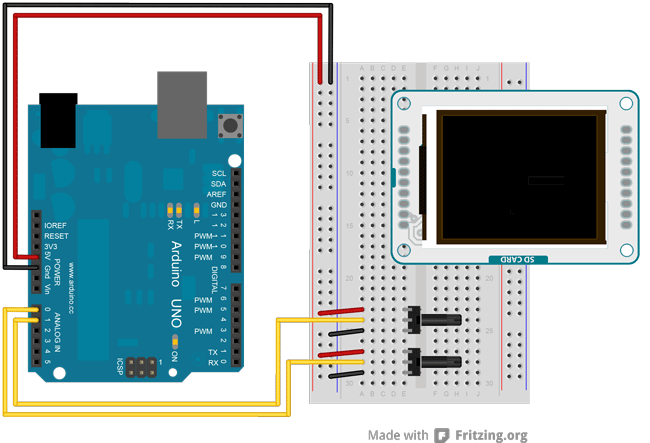Examples > TFT
TFT Pong

This sketch is a basic implementation of pong for the TFT screen with an Arduino Uno.
This version of the game creates a rectangular platform that can move in two directions, and a ball that bounces against the edges of the screen as well as the movable platform. Two potentiometers (or other analog sensor) control the position of the platform.
The example demonstrates collision detection between objects on the screen, as well as how to quickly update images without erasing the entire screen every loop()
Hardware Required
- Arduino Uno
- Arduino TFT screen
- breadboard
- hookup wire
- two 10-kilohm potentiometers
Circuit
Connect power and ground to the breadboard.
Show the circuitShow the circuit
Place the potentiometers on the breadboard. On each pot, connect one side to ground, and the other to power. Connect the middle pin of one potentiometer to A0, the other one to A1.
Show the circuitShow the circuit
Connect the TFT screen to the breadboard. The headers on the side of the screen with the small blue tab and arrow should be the ones that attach to the board. Pay attention to the orientation of the screen, in these images, it is upside down.
Show the circuitShow the circuit
Connect the BL and +5V pins to power, and GND to ground. Connect CS-LD to pin 10, DC to pin 9, RESET to pin 8, MOSI to pin 11, and SCK to pin 13. If uyou're using a Leonardo, you'll be using different pins. see the getting started page for more details.
Show the circuitShow the circuit
Code
To use the screen you must first include the SPI and TFT libraries.
#include <TFT.h>
Define the pins you're going to use for controlling the screen, and create an instance of the TFT library named TFTscreen. You'll reference that object whenever you're working with the screen.
#define dc 9
#define rst 8
TFT TFTscreen = TFT(cs, dc, rst);
Set up the variables for the ball and paddle x & y positions, the ball's direction, and the previous locations of the ball and paddle.
int paddleY = 0;
int oldPaddleX, oldPaddleY;
int ballDirectionX = 1;
int ballDirectionY = 1;
int ballX, ballY, oldBallX, oldBallY;
In setup(), initialize the display and clear the screen's background.
TFTscreen.begin();
TFTscreen.background(0,0,0);
}
loop() starts by storing the width and height of the screen, an reading the values of the potentiometers, before mapping them to a useful range.
int myWidth = TFTscreen.width();
int myHeight = TFTscreen.height();
paddleX = map(analogRead(A0), 0, 1023, 0, myWidth) - 20/2;
paddleY = map(analogRead(A1), 0, 1023, 0, myHeight) - 5/2;
Set the fill color to black, and erase the previous location of the paddle if it has moved.
if (oldPaddleX != paddleX || oldPaddleY != paddleY) {
TFTscreen.rect(oldPaddleX, oldPaddleY, 20, 5);
}
Set the fill color to white, and draw the paddle.
TFTscreen.rect(paddleX, paddleY, 20, 5);
Save the paddle's current location as the previous location, so the next time through you can check if it has moved.
oldPaddleY = paddleY;
At the end of loop(), use the value of the ballSpeed variable to determine how quickly the display will update. Once you've finished with the example, you could add another potentiometer and change the speed dynamically by changing the value of ballSpeed.
You'll call a custom function named moveBall() to update the ball's position.
moveBall();
}
}
moveBall() will update the ball's position, erase its previous location, and draw it in the new spot. It will also check to make sure it does not go off the screen, reversing direction when it hits the sides. This also calls a second custom function named inPaddle() which checks for intersections of the ball and paddle.
if (ballX > TFTscreen.width() || ballX < 0) {
ballDirectionX = -ballDirectionX;
}
if (ballY > TFTscreen.height() || ballY < 0) {
ballDirectionY = -ballDirectionY;
}
if (inPaddle(ballX, ballY, paddleX, paddleY, 20, 5)) {
ballDirectionY = -ballDirectionY;
}
ballX += ballDirectionX;
ballY += ballDirectionY;
TFTscreen.fill(0,0,0);
if (oldBallX != ballX || oldBallY != ballY) {
TFTscreen.rect(oldBallX, oldBallY, 5, 5);
}
TFTscreen.fill(255,255,255);
TFTscreen.rect(ballX, ballY, 5, 5);
oldBallX = ballX;
oldBallY = ballY;
}
inPaddle() checks to see if the paddle and ball occupy the same space. If so, it returns TRUE, which reverses the ball's direction in moveBall().
boolean result = false;
if ((x >= rectX && x <= (rectX + rectWidth)) &&
(y >= rectY && y <= (rectY + rectHeight))) {
result = true;
}
return result;
}
The complete sketch is below :
TFT Pong
This example for the Arduino screen reads the values
of 2 potentiometers to move a rectangular platform
on the x and y axes. The platform can intersect
with a ball causing it to bounce.
This example code is in the public domain.
Created by Tom Igoe December 2012
Modified 15 April 2013 by Scott Fitzgerald
http://www.arduino.cc/en/Tutorial/TFTPong
*/
#include <TFT.h> // Arduino LCD library
#include <SPI.h>
// pin definition for the Uno
#define cs 10
#define dc 9
#define rst 8
// pin definition for the Leonardo
// #define cs 7
// #define dc 0
// #define rst 1
TFT TFTscreen = TFT(cs, dc, rst);
// variables for the position of the ball and paddle
int paddleX = 0;
int paddleY = 0;
int oldPaddleX, oldPaddleY;
int ballDirectionX = 1;
int ballDirectionY = 1;
int ballSpeed = 10; // lower numbers are faster
int ballX, ballY, oldBallX, oldBallY;
void setup() {
// initialize the display
TFTscreen.begin();
// black background
TFTscreen.background(0, 0, 0);
}
void loop() {
// save the width and height of the screen
int myWidth = TFTscreen.width();
int myHeight = TFTscreen.height();
// map the paddle's location to the position of the potentiometers
paddleX = map(analogRead(A0), 512, -512, 0, myWidth) - 20 / 2;
paddleY = map(analogRead(A1), 512, -512, 0, myHeight) - 5 / 2;
// set the fill color to black and erase the previous
// position of the paddle if different from present
TFTscreen.fill(0, 0, 0);
if (oldPaddleX != paddleX || oldPaddleY != paddleY) {
TFTscreen.rect(oldPaddleX, oldPaddleY, 20, 5);
}
// draw the paddle on screen, save the current position
// as the previous.
TFTscreen.fill(255, 255, 255);
TFTscreen.rect(paddleX, paddleY, 20, 5);
oldPaddleX = paddleX;
oldPaddleY = paddleY;
// update the ball's position and draw it on screen
if (millis() % ballSpeed < 2) {
moveBall();
}
}
// this function determines the ball's position on screen
void moveBall() {
// if the ball goes offscreen, reverse the direction:
if (ballX > TFTscreen.width() || ballX < 0) {
ballDirectionX = -ballDirectionX;
}
if (ballY > TFTscreen.height() || ballY < 0) {
ballDirectionY = -ballDirectionY;
}
// check if the ball and the paddle occupy the same space on screen
if (inPaddle(ballX, ballY, paddleX, paddleY, 20, 5)) {
ballDirectionX = -ballDirectionX;
ballDirectionY = -ballDirectionY;
}
// update the ball's position
ballX += ballDirectionX;
ballY += ballDirectionY;
// erase the ball's previous position
TFTscreen.fill(0, 0, 0);
if (oldBallX != ballX || oldBallY != ballY) {
TFTscreen.rect(oldBallX, oldBallY, 5, 5);
}
// draw the ball's current position
TFTscreen.fill(255, 255, 255);
TFTscreen.rect(ballX, ballY, 5, 5);
oldBallX = ballX;
oldBallY = ballY;
}
// this function checks the position of the ball
// to see if it intersects with the paddle
bool inPaddle(int x, int y, int rectX, int rectY, int rectWidth, int rectHeight) {
bool result = false;
if ((x >= rectX && x <= (rectX + rectWidth)) &&
(y >= rectY && y <= (rectY + rectHeight))) {
result = true;
}
return result;
}




